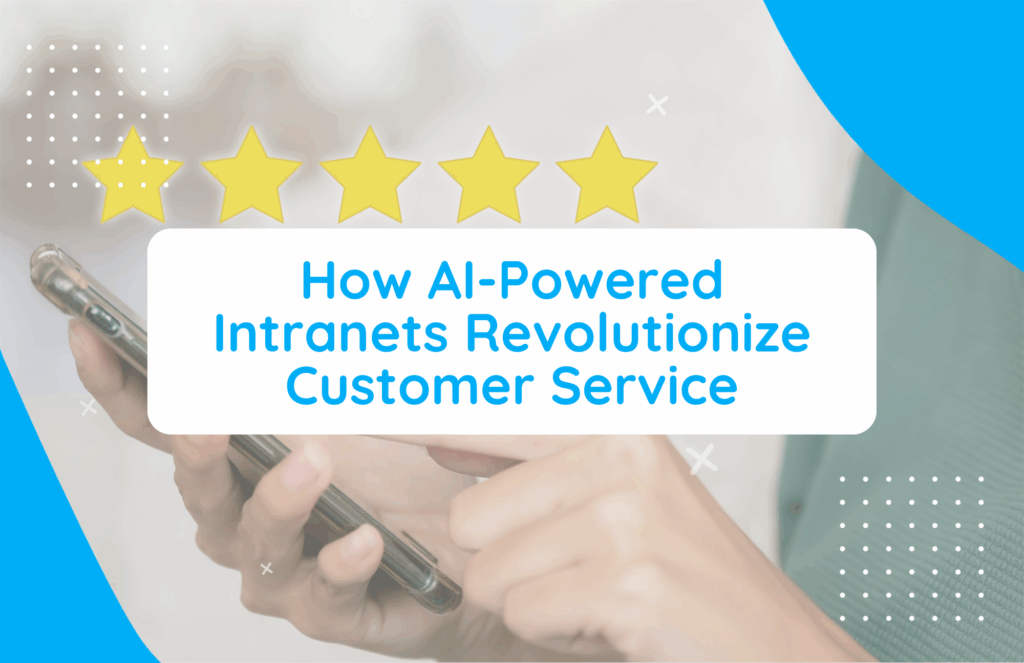Suppose your organization is among the growing businesses that use remote and hybrid teams to get things done. In that case, you understand the challenges of maintaining a productive work culture across dispersed staff. A modern intranet is the key to reshaping company culture and delivering an engaging employee experience to every team member, regardless of where or when they work.
Here’s everything you need to know about building a remote work culture with a modern intranet, including why it’s time to switch.
What Is a Modern Intranet?
A modern intranet is a dynamic, cloud-based platform designed to centralize resources, simplify internal communication, and streamline workflows. A traditional company intranet lacks personalization and flexibility, making it poorly suited to the needs of remote workers.
Modern alternatives promote employee engagement and productivity by delivering a user-centric, personalized experience. Remote employees will enjoy relevant feeds based on their roles, locations, and individual needs.
The top options allow you to create an innovative digital workspace integrated with collaboration tools and resources your team uses daily.
Key Features of a Modern Intranet
When selecting an employee intranet, ensuring a platform has the functionality you need to support remote teams is vital. Leading intranet solutions include the following must-have features:
Centralized Communication
The best platforms facilitate real-time messaging and simplified feedback loops via integrated communication tools. Promoting communication across your decentralized workforce yields a better user experience and helps team members share information promptly.
Centralizing communication keeps everyone informed about important deadlines, projects, and business demands. They can tap into timely, relevant knowledge using forums, searchable policies, and built-in communication tools, all within the intranet platform.
Integrated Tools
A modern intranet seamlessly connects with existing software like Microsoft Teams, Slack, and Zoom, resulting in a unified digital workspace.
When exploring intranet software, prioritize solutions that support easy integration with tools already in your work environment. For instance, if your team heavily relies on Microsoft applications, choosing an intranet like hubley, which is built on SharePoint, can simplify the implementation process.
Our central hub gives your team members the tools they need to be more productive when working remotely or in a hybrid environment.
Personalization
Old-school corporate intranet platforms were bland. They lacked the personalization capabilities that today’s employees expect and crave. The result is reduced information sharing and lower engagement.
Unlike traditional intranets, modern solutions like hubley can deliver personalization at scale. This capability reinforces company values and creates a sense of belonging among co-workers. Making your employees feel like they belong can promote retention and teamwork.
Mobile Accessibility
Mobile accessibility is essential, especially when supporting a remote workforce. Modern intranets include mobile apps, which keep your team members connected while in the office, on the go, or working remotely. Platforms like hubley are compatible with many mobile devices, including iOS and Android.
Employees can use the mobile app to stay updated on company news, send time-sensitive communications, and receive notifications on their phones. Making engaging content more accessible is a key to reshaping remote work culture.
Robust Security
Consolidating documents and critical information in one place can raise security concerns. Therefore, it is essential to address any apprehensions about transitioning to a cloud-based intranet platform by choosing a solution that prioritizes security.
An intranet with secure document management capabilities protects confidential or sensitive information while making critical resources accessible to off-site employees.
When comparing intranet solutions, prioritize platforms that offer role-based access control and encryption capabilities. You should also consider your IT team’s familiarity with the solution’s architecture. For instance, hubley is built on the familiar SharePoint architecture, enabling your IT staff to promote a strong security posture.
Building a Remote Work Culture with a Modern Intranet
Now that you know what to look for in a modern intranet, the question becomes, how can you use it to build a remote work culture? Here are some critical use cases for a modern, cloud-based intranet platform.
Enhance Communication
Enhanced communication is one of a modern intranet’s most valuable applications. A modern solution provides a platform for delivering company-wide announcements about initiatives, promoting employee recognition, and introducing new employees. These are just a few examples of communicating better with a cloud-based intranet.
Communication among remote teams can suffer when they don’t have the right tools. You can prevent this challenge by integrating top communication applications into your intranet. Employees can access the tools they need from a single location, which promotes better adoption and improved communication.
Foster Collaboration
A powerful intranet solution enables your team members to work together on projects in real time, even if they aren’t in the same office space. They can share documents, provide feedback, and combine their talents regardless of location.
Many top project management platforms can integrate with cloud-based intranets. Combining these powerful tools gives your team real-time metrics and data points regarding current projects. They can track due dates, improve visibility, and keep projects on track.
Encourage Engagement
A modern intranet creates a digital workplace that promotes engagement across frontline workers, C-suite members, and everyone. A top option like hubley isn’t just an intranet but a true employee experience platform.
The social media-like feed keeps users intrigued about the organization and current happenings. They can stay connected with co-workers and the company in a leisurely, accessible way.
Support Onboarding and Training
Bringing a promising new hire into the fold is a win for your business. However, you’ve got to nail the onboarding and training process, so they stick around for the long haul. That can be tough under any circumstances, but it’s especially challenging when managing remote or hybrid new hires.
A modern intranet provides new employees with access to a repository of resources and training modules. They can use these tools to acclimate quickly and contribute to the organization’s success.
Existing employees will also benefit from the training tools built into cloud-based intranets. They can review documents relevant to their positions, track their training progress, and develop new skills.
Essential Tools for Remote Work Integration
A great intranet lays the foundation for a strong remote work culture. However, you must also build the platform by integrating powerful, user-friendly tools that your team will love. Some of the types of tools you will need include the following:
- Communication Platform: Slack, Microsoft Teams
- Project Management: Microsoft Project, Microsoft Planner, Asana, Trello
- File Sharing: Google Drive, Dropbox, OneDrive
- Time Tracking: Hubstaff
- Video Conferencing: Microsoft Teams, Zoom, Google Meet
These integrations streamline workflows and reduce the need to bounce between multiple applications. Keeping your team within the intranet simplifies their workday and minimizes time wasted logging into various applications.
Implementing a Modern Intranet for Remote Work
Ready to build a winning remote work culture with a cloud-based intranet? Here’s what you need to do next:
Assess Your Needs
Start by evaluating your current needs and the capabilities of your existing intranet solution (if you have one). Consider why you want to upgrade and what you hope to accomplish. Identify specific challenges and how a cloud-based intranet will help you overcome them. Some common goals include the following:
- Promoting communication
- Encouraging a better work-life balance
- Limiting stress on your team
- Reducing the need for redundant, manual work
- Increasing engagement among remote and hybrid teams
- Facilitating better collaboration
Next, identify what intranet features you need to achieve these goals. Make a short list of potential platforms and start your search.
Choose the Right Platform
Now is the time to find the ideal intranet for your business. Use the information you compiled in the previous step to identify the best fit. Consider everything from cost to ease of implementation. Take advantage of demo opportunities and involve frontline workers in your search. After all, they will be using it every day, too.
Keep in mind that some team members may be resistant to the change. Address their concerns directly and discuss how the change will make their day-to-day work easier. When you focus on the benefits and acknowledge their problems, you can promote a more substantial ROI and decreased time to value.
Promote User Adoption
Getting your team on board with transparent communication is a great start. However, you must also empower them with training and support to encourage them to use the intranet to its full potential.
After a single session, your employees probably won’t remember all the tools an intranet includes. With that in mind, reinforce the information you present through follow-up sessions and provide your team with resources they can keep, such as a quick reference guide.
Regularly Update Content
Keep the information within your intranet current, relevant, and valuable. Consider publishing news and other content daily so that employees have a reason to interact with the platform. However, make sure that everything you publish adds value. Otherwise, team members may become frustrated with constant notifications and alerts.
Encourage employees and leaders from across the business to be active on the platform. User-generated content is authentic and can be fun to interact with. Just set some ground rules regarding what can and cannot be published.
Gather Feedback
After you’ve implemented your intranet, gather user input to improve it. Anonymous surveys are a good place to start, as team members may be willing to share negative feedback in this format. Once you’ve gauged overall sentiments about the intranet, consider hosting a town hall-style meeting. Encourage everyone to discuss the good and the bad.
During these conversations, let your team members know you’ve heard their concerns and reassure them that you will do what you can to solve them. Remember, the intranet is a place for everyone. Therefore, the improvement process needs to involve the entire team.
The Role of Leadership and HR
You are key to cultivating a remote work culture as an organizational leader. HR is also critical to this journey. Here are a few ways that you and other business leaders can use your intranet to cultivate a culture that’s conducive to remote work:
- Share the company’s values, mission, and goals
- Highlight employee accomplishments to boost morale and motivation
- Offer access to wellness programs and other support services
Encourage your team members to download the mobile app and enable notifications so they can stay connected to the company. Just be careful not to come off as pushy. You want your employees to feel empowered and engaged, not forced to add another “thing” to their workload.
Measuring Success
How do you know if your intranet made an impact on company culture? Here are a few metrics to watch:
- Employee Engagement Scores: Assess participation in intranet activities and feedback surveys
- Productivity Levels: Monitor project completion rates to see if your team is achieving more
- Retention Rates: Track employee turnover and satisfaction levels
Keep in mind that reshaping company culture takes time. Even with a modern intranet, you won’t hit your goals overnight. Monitor your progress, build on what works, and fix what doesn’t. Over time, you can create a culture where everyone wants to participate.
Building a Remote Work Culture With hubley
A modern intranet platform lays the foundation for creating a remote work culture where team members feel supported, empowered, and engaged. The key is to choose the right solution for your business.
Enter hubley. Our customizable, user-friendly platform has tools and features designed to support your employees, no matter where they work. The hubley platform is built on SharePoint, promoting seamless integration with popular applications like the Microsoft Office Suite.
Ready to achieve more? Schedule a demo of hubley today.









